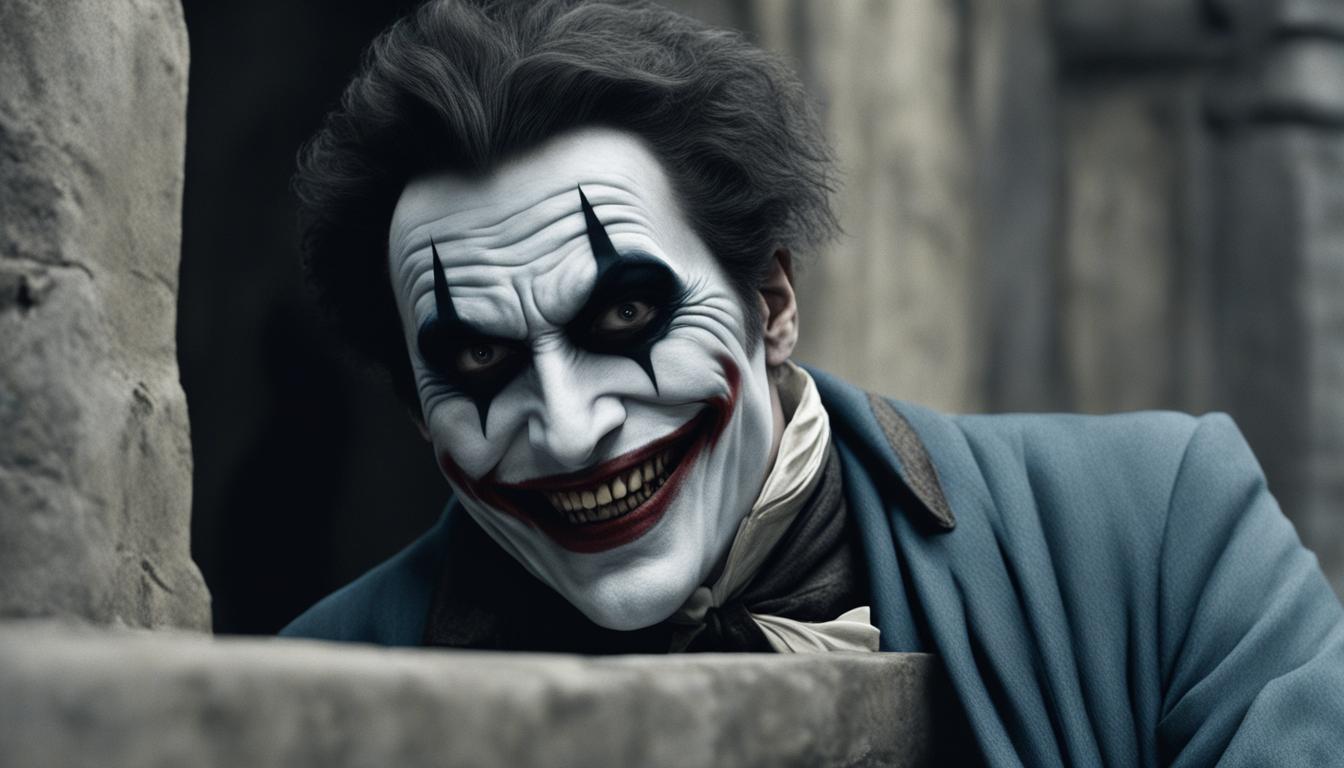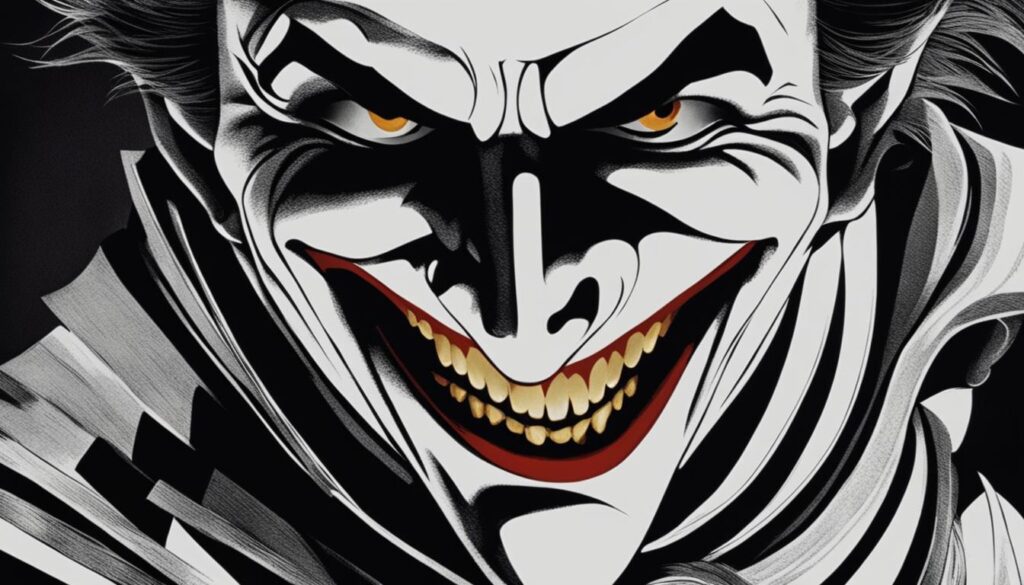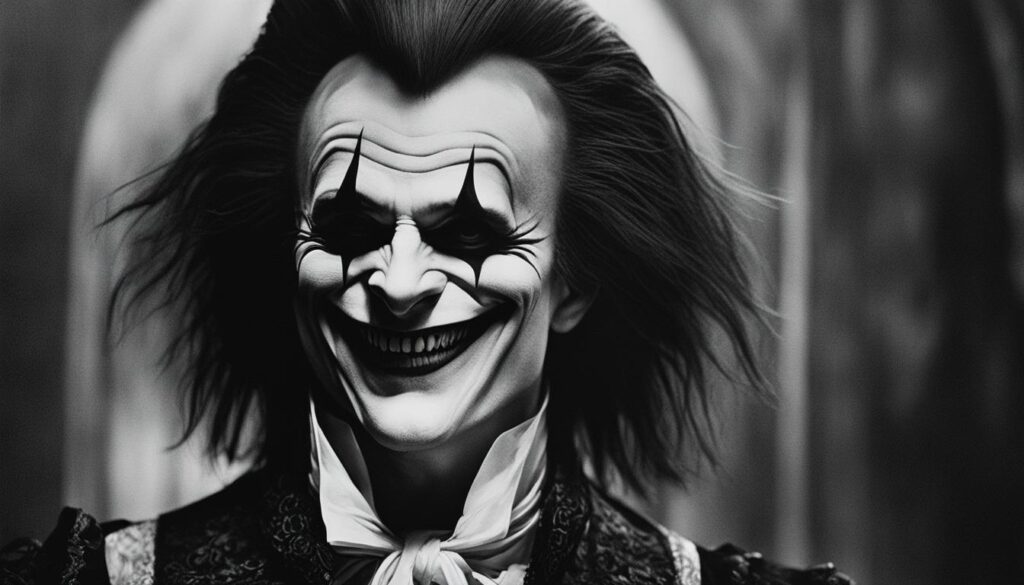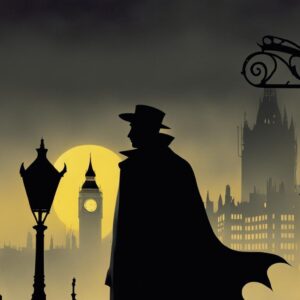When it comes to classic films, there are few that have stood the test of time quite like The Man Who Laughs (1928). Based on the novel by Victor Hugo, this movie is a captivating blend of horror and romance, featuring a remarkable performance by Conrad Veidt as the disfigured protagonist, Gwynplaine. As a silent film, it relies on the expressive performances of the actors and innovative cinematic techniques to create a truly unforgettable experience.
Key Takeaways:
- The Man Who Laughs (1928) is a classic film that combines horror and romance.
- Conrad Veidt delivers a remarkable performance as the disfigured protagonist, Gwynplaine.
- The film’s use of silent film techniques adds to its unique and haunting atmosphere.
- Its themes of identity, love, and social inequality still resonate with audiences today.
- The Man Who Laughs has had a significant influence on the horror genre and popular culture.
The History of The Man Who Laughs
The Man Who Laughs (1928) is a film that holds a significant place in the history of cinema. Directed by Paul Leni and based on the novel by Victor Hugo, this classic silent movie has captivated audiences for over nine decades. Released in 1928, The Man Who Laughs is one of the earliest examples of the horror genre and has left a lasting impact on filmmaking.
The story revolves around Gwynplaine, a man with a disfigured face, who becomes a famous performer known as “The Man Who Laughs.” The film’s exploration of horror and romance, combined with Conrad Veidt’s mesmerizing performance in the lead role, has made it a standout in cinematic history.
Upon its release, The Man Who Laughs received critical acclaim for its innovative storytelling and visual effects. The film’s atmospheric lighting and set design created a dark and haunting atmosphere that perfectly complemented the narrative. The Man Who Laughs continues to be celebrated as a masterpiece, showcasing the talents of the filmmakers and actors involved.
The History of The Man Who Laughs
| Year | Event |
|---|---|
| 1928 | The Man Who Laughs is released, becoming one of the earliest examples of the horror genre in cinema. |
| 1928 | The film receives critical acclaim for its innovative storytelling and visual effects. |
| 1928 | Conrad Veidt’s performance as Gwynplaine in The Man Who Laughs becomes one of the standout aspects of the movie. |
The Cast of The Man Who Laughs
The Man Who Laughs (1928) boasts a talented cast that brings the characters to life with their exceptional performances. Conrad Veidt takes on the lead role of Gwynplaine, delivering a mesmerizing portrayal of a man with a disfigured face. His raw emotions and physicality command the screen, leaving a lasting impression on the audience.
Mary Philbin shines as Dea, the love interest of Gwynplaine. Her delicate portrayal adds depth and vulnerability to the story, creating a beautiful contrast to Gwynplaine’s tragic character. The chemistry between Veidt and Philbin is palpable, capturing the essence of their characters’ love and connection.
The supporting cast also deserves recognition for their contributions to the film. From Olga Baclanova’s captivating performance as the villainous Duchess Josiana to Cesare Gravina’s endearing portrayal of the loyal sidekick, Ursus, each actor brings their unique presence to the screen, enhancing the overall impact of the film.
| Cast Member | Character |
|---|---|
| Conrad Veidt | Gwynplaine |
| Mary Philbin | Dea |
| Olga Baclanova | Duchess Josiana |
| Cesare Gravina | Ursus |
The memorable performances of the cast elevate The Man Who Laughs, adding depth and emotion to the story. Their talent and dedication bring the characters to life, making the film a true cinematic masterpiece.
The Influence of The Man Who Laughs
The Man Who Laughs (1928) has left an indelible mark on the horror genre, inspiring countless filmmakers and actors. With its unique blend of horror and romance, this classic movie continues to captivate audiences to this day. Its influence can be seen in the way subsequent films have emulated its themes and storytelling techniques.
One of the film’s most enduring legacies is its depiction of a tragic protagonist. The disfigurement of Gwynplaine’s face serves as a haunting symbol of the way society treats those who are different. This portrayal has become a popular archetype in storytelling and has been echoed in many films since.
The Man Who Laughs also paved the way for the exploration of complex emotions and human connections in horror movies. Its powerful portrayal of love and its impact on the characters resonates with viewers, showcasing the depth and emotional range of the genre.
Table: The Influence of The Man Who Laughs
| Impact | Description |
|---|---|
| Inspired Filmmakers | The Man Who Laughs has been a source of inspiration for many filmmakers, influencing their storytelling techniques and artistic vision. |
| Emulated Themes | The film’s exploration of identity, love, and social inequality has been emulated in numerous subsequent horror movies. |
| Popular Archetype | The tragic protagonist with a disfigured face has become a popular archetype in storytelling, evident in many films across different genres. |
| Emotional Impact | The Man Who Laughs delves into the complexities of love and human connection, showcasing the emotional depth that can be achieved within the horror genre. |
The Cinematic Techniques of The Man Who Laughs
The Man Who Laughs (1928) showcases innovative cinematic techniques that were ahead of its time. The film’s use of silent film allows the audience to focus on the expressive performances of the actors and enhances the emotional impact of the story. The cinematography of The Man Who Laughs is visually captivating, utilizing atmospheric lighting and intricate set designs to create a dark and haunting atmosphere.
One notable cinematic technique employed in The Man Who Laughs is the use of close-ups to capture the emotions and facial expressions of the characters. Conrad Veidt’s portrayal of Gwynplaine, with his disfigured face and haunting smile, is particularly striking in close-up shots, creating a sense of unease and empathy in the audience.
“The Man Who Laughs is a masterpiece of visual storytelling, with its intricate framing and composition. The use of shadows and contrast adds depth and intensity to the scenes, further immersing the audience into the world of Gwynplaine and his tragic story.” – Film Critic
The film also utilizes creative editing techniques to enhance the narrative. The Man Who Laughs incorporates montages and cross-cutting to build suspense and highlight the connections between different characters and storylines. These editing techniques contribute to the overall tension and pacing of the film, keeping the audience engaged throughout.
| Cinematic Techniques | Effects |
|---|---|
| Use of silent film | Enhances the expressive performances and emotional impact |
| Close-up shots | Highlights the emotions and facial expressions of the characters |
| Atmospheric lighting and set design | Creates a dark and haunting atmosphere |
| Creative editing techniques (montages and cross-cutting) | Builds suspense and highlights connections between characters and storylines |
The cinematic techniques employed in The Man Who Laughs contribute to its enduring impact and make it a must-watch for film enthusiasts and fans of the horror genre. The film’s visual storytelling, with its expressive performances, atmospheric lighting, and creative editing, continues to captivate audiences and solidify its status as a classic in cinema history.
The Themes and Symbolism of The Man Who Laughs
The Man Who Laughs (1928) explores themes of identity, love, and social inequality. One of the key themes in the film is the concept of identity and how society treats those who are different. The disfigurement of the main character Gwynplaine’s face serves as a powerful symbol, representing the way society often judges individuals based on their appearance. Gwynplaine’s disfigurement becomes a metaphor for the harsh treatment of those who are seen as “different” in society.
Love is another central theme in The Man Who Laughs. The relationship between Gwynplaine and Dea, his love interest, is portrayed as pure and unconditional. Their love transcends Gwynplaine’s physical appearance, highlighting the power of human connection and the ability to find love and acceptance despite the challenges one may face.
The film also delves into social inequality, exploring the stark divide between the rich and the poor. This theme is depicted through the character of Lord Clancharlie, who represents the privileged upper class, and Gwynplaine, who comes from a lower-class background. The Man Who Laughs critiques the societal structures that perpetuate inequality and the hardships faced by those who are marginalized.
The Symbolism of Gwynplaine’s Disfigurement
“The disfigurement of Gwynplaine’s face serves as a powerful symbol, representing the way society often judges individuals based on their appearance.”
The Man Who Laughs, based on the novel by Victor Hugo, uses symbolism to convey its themes effectively. The disfigurement of Gwynplaine’s face is a central symbol that carries a deep meaning throughout the film. It highlights the prejudice and discrimination faced by those who do not conform to society’s ideals of beauty and perfection.
The disfigurement also serves as a catalyst for the story, setting Gwynplaine apart from others and shaping his experiences and relationships. It forces the audience to confront their own biases and question the way they perceive others based on their physical appearance.
Overall, The Man Who Laughs is a thought-provoking film that uses themes and symbolism to explore profound questions about identity, love, and social inequality. It remains a timeless classic that continues to resonate with audiences, highlighting the enduring power of cinema to spark introspection and evoke emotions.
| Themes | Symbolism |
|---|---|
| Identity | Gwynplaine’s disfigurement represents the judgment of individuals based on appearance. |
| Love | Gwynplaine and Dea’s unconditional love transcends physical appearance. |
| Social Inequality | The divide between the rich and the poor is highlighted through the characters of Gwynplaine and Lord Clancharlie. |
The Reception of The Man Who Laughs
The Man Who Laughs (1928) received widespread acclaim upon its release, with critics and audiences praising its atmospheric storytelling and powerful performances. The film’s unique blend of horror and romance captivated viewers and left a lasting impact on the genre. Its haunting visuals and emotional depth resonated with audiences of the time and continue to captivate new generations of film enthusiasts.
Movie reviews for The Man Who Laughs praised Conrad Veidt’s exceptional performance as Gwynplaine and Mary Philbin’s captivating portrayal of Dea. The chemistry between the two actors brought depth and authenticity to their characters, adding an extra layer of emotion to the story. The film’s evocative cinematography and atmospheric lighting further enhanced the overall experience, creating a dark and haunting atmosphere that stayed with viewers long after the credits rolled.
Over the years, The Man Who Laughs has gained a cult following and is celebrated as a classic in the horror genre. Its unique storytelling and powerful themes of identity and love have left a lasting impact on filmmakers and audiences alike. The film’s positive reception and enduring popularity are a testament to its status as a true cinematic gem.
| Review Quotes: |
|---|
|
|
|
The Legacy of The Man Who Laughs
The Man Who Laughs (1928) has left an indelible mark on the world of cinema, cementing its legacy as a classic film that continues to inspire and captivate audiences. Its influence can be felt in subsequent horror films, as well as in popular culture as a whole. The Man Who Laughs is more than just a movie; it is a testament to the power of storytelling and the lasting impact that a well-crafted film can have.
One of the key elements that contributes to the legacy of The Man Who Laughs is its unique blend of horror and romance. The film seamlessly weaves together these two genres, creating a captivating narrative that engages the viewers on both an emotional and psychological level. This combination of elements has inspired countless filmmakers and has become a benchmark for other films in the genre to aspire to.
Furthermore, The Man Who Laughs introduced audiences to the tragic protagonist archetype, a character who is disfigured physically but possesses a depth of character and resilience that resonates with viewers. This portrayal has had a profound impact on storytelling, influencing future films that explore similar themes of identity, love, and social inequality.
| Legacy | Influence | Impact |
|---|---|---|
| Continues to inspire filmmakers | Shaped the horror genre | Embraced by audiences as a classic |
| Explored themes of identity, love, and social inequality | Inspired subsequent films | Introduced the tragic protagonist archetype |
| Enduring popularity and cult following | Emulated cinematography and visual effects | Influenced popular culture and storytelling |
The enduring popularity of The Man Who Laughs is a testament to its timeless appeal. The film continues to be celebrated by cinephiles and enthusiasts, and its digital restoration has allowed new generations to discover and appreciate its beauty. As we look back on the legacy of The Man Who Laughs, it is clear that its impact on cinema and popular culture will continue to be felt for years to come.
Rediscovering The Man Who Laughs
Recently, The Man Who Laughs (1928) has been experiencing a resurgence in popularity, thanks to digital restoration and a renewed interest in silent films. This classic movie, known for its captivating storytelling and powerful performances, has been showcased at film festivals and special events, allowing new generations of audiences to discover its beauty and power.
Thanks to advancements in technology, the film has been restored to its original glory, preserving the stunning visuals and atmospheric cinematography that made it a masterpiece of its time. This digital restoration has allowed audiences to fully appreciate the expressive performances and unique blend of horror and romance that The Man Who Laughs offers.
The allure of silent cinema has also contributed to the renewed interest in The Man Who Laughs. The absence of dialogue allows viewers to focus on the visual storytelling and the emotions conveyed by the talented cast. Conrad Veidt’s portrayal of Gwynplaine, with his disfigured face and haunting presence, continues to captivate audiences and solidify this film as a classic.
The Man Who Laughs and the Joker Connection
The Man Who Laughs (1928) is often cited as a major influence on the creation of the iconic character, the Joker, in the Batman comics. Conrad Veidt’s portrayal of Gwynplaine’s disfigured face and haunting presence is said to have inspired the visual design and characterization of the Joker. The Man Who Laughs and the Joker share similarities in their tragic backgrounds and their ability to find humor in the face of adversity.
In The Man Who Laughs, Gwynplaine’s disfigurement is a result of the “Glasgow Smile,” a horrifying form of punishment. This gruesome image of a permanently smiling face resonated with audiences and has since become synonymous with the Joker character. Both Gwynplaine and the Joker represent the duality of human nature, with their appearance concealing their true emotions and motivations.
Another connection between The Man Who Laughs and the Joker can be found in their shared sense of dark humor. Gwynplaine, despite his tragic circumstances, becomes a performer known as “The Man Who Laughs,” using his disfigurement as a source of entertainment. Similarly, the Joker is known for his twisted sense of humor and his ability to find amusement in violence and chaos.
Conrad Veidt’s performance in The Man Who Laughs laid the foundation for the iconic portrayal of the Joker in subsequent adaptations.
The influence of The Man Who Laughs on the Joker character can be seen not only in the visual design but also in the psychological depth and complexity of the character. Gwynplaine and the Joker both explore themes of identity, societal rejection, and the fine line between tragedy and comedy.
| The Man Who Laughs (1928) | The Joker |
|---|---|
| Based on the novel by Victor Hugo | Created by Bill Finger, Bob Kane, and Jerry Robinson |
| Portrayed by Conrad Veidt | Portrayed by various actors, including Heath Ledger, Joaquin Phoenix, and Jack Nicholson |
| Disfigured face with a permanent smile | White face with a permanent smile |
| Tragic backstory and complex motivations | Tragic backstory and complex motivations |
| Emphasizes dark humor | Emphasizes dark humor |
The Man Who Laughs: An Underrated Gem
When it comes to classic films, one title that often gets overlooked is The Man Who Laughs (1928). Despite its critical acclaim and lasting legacy, this cinematic masterpiece remains relatively unknown to many moviegoers. However, for those who have had the pleasure of watching it, The Man Who Laughs proves to be an unforgettable and captivating experience.
Based on the novel by Victor Hugo, The Man Who Laughs tells the haunting story of Gwynplaine, a man with a disfigured face who becomes a famous performer known as “The Man Who Laughs.” Conrad Veidt delivers a remarkable performance in the lead role, bringing depth and emotion to the character. Paired with Mary Philbin’s portrayal of the love interest, Dea, the chemistry between the two actors is palpable and adds to the overall impact of the film.
What sets The Man Who Laughs apart is its unique blend of horror and romance. Director Paul Leni expertly combines these genres, creating a truly atmospheric and captivating film. The cinematography and visual effects of the time are also innovative and add to the overall experience. The film’s use of silent storytelling allows the audience to fully appreciate the expressive performances of the actors, making it a true gem of early cinematic history.
Despite its relative obscurity, The Man Who Laughs deserves recognition as a masterpiece in its own right. Its powerful storytelling, captivating performances, and unique blend of genres make it a film that should not be missed by any movie enthusiast or fan of classic cinema.
The Man Who Laughs: A Must-Watch for Film Enthusiasts
As a film enthusiast, I highly recommend watching The Man Who Laughs (1928). This classic movie, directed by Paul Leni, continues to captivate audiences with its captivating storytelling, innovative cinematography, and powerful performances. Whether you are a fan of silent films or simply appreciate great storytelling, The Man Who Laughs is a film that should not be missed.
The Man Who Laughs tells the story of Gwynplaine, a man with a disfigured face, who becomes a famous performer known as “The Man Who Laughs”. Conrad Veidt delivers a remarkable performance in the lead role, bringing depth and emotion to the character. His portrayal of Gwynplaine’s haunting presence is truly mesmerizing.
The film also showcases stunning visual effects and atmospheric lighting, creating a dark and haunting atmosphere that adds to the overall impact of the story. The use of silent film allows the audience to fully appreciate the expressive performances of the actors, making every emotion and nuance more pronounced.
Whether you are a fan of classic movies, silent cinema, or simply enjoy a compelling story, The Man Who Laughs is a must-watch. Its timeless themes of identity, love, and social inequality, combined with its powerful performances, make it a true cinematic gem that deserves recognition and appreciation.
The Man Who Laughs: A Timeless Classic
The Man Who Laughs (1928) is a cinematic masterpiece that continues to captivate audiences with its haunting story and memorable performances. Directed by Paul Leni and based on the novel by Victor Hugo, this film stands as a testament to the artistry and enduring power of silent cinema.
Set in 17th-century England, The Man Who Laughs tells the story of Gwynplaine, a man with a disfigured face who becomes a renowned performer in a traveling circus. Conrad Veidt delivers a mesmerizing performance in the lead role, capturing the anguish, resilience, and vulnerability of the character.
“The Man Who Laughs is a haunting exploration of identity, love, and the human spirit, wrapped in a compelling tale of horror and romance.”
The film delves into themes of identity, love, and social inequality, using Gwynplaine’s disfigured face as a potent symbol of the societal rejection of those who are different. It also explores the transformative power of love and the enduring human spirit in the face of adversity.
With its atmospheric cinematography, beautifully crafted sets, and captivating performances, The Man Who Laughs continues to be hailed as a classic in the horror genre. Its influence can be seen in subsequent films that have embraced a similar blend of horror and romance.
Experience the timeless magic of The Man Who Laughs (1928) and rediscover the power of silent cinema. This classic film remains a testament to the enduring nature of storytelling and its ability to touch hearts across generations.
Conclusion
The Man Who Laughs (1928) is truly a classic film that should not be overlooked. Its stunning visuals, powerful performances, and thought-provoking storytelling make it a timeless masterpiece. Whether you are a fan of classic movies, silent cinema, or simply appreciate great storytelling, The Man Who Laughs is a must-watch.
This film has had a significant influence on the horror genre and popular culture as a whole. Its unique blend of horror and romance, along with its exploration of themes like identity and love, has inspired countless filmmakers and actors. The Man Who Laughs continues to be celebrated as a classic in the genre.
For anyone looking to dive into the world of classic cinema, The Man Who Laughs is a perfect starting point. Its captivating story, innovative cinematography, and powerful performances will leave a lasting impression. Don’t miss out on experiencing this true cinematic gem.
FAQ
What is The Man Who Laughs?
The Man Who Laughs is a classic film released in 1928, based on the novel by Victor Hugo, and directed by Paul Leni.
Who stars in The Man Who Laughs?
Conrad Veidt delivers a remarkable performance as the main character, Gwynplaine, while Mary Philbin plays the role of the love interest, Dea.
What is the genre of The Man Who Laughs?
The film combines elements of horror and romance, creating a unique cinematic experience.
What is the significance of The Man Who Laughs?
The Man Who Laughs is considered a masterpiece in the horror genre and has had a significant influence on subsequent films and popular culture.
What are the themes explored in The Man Who Laughs?
The film explores themes of identity, love, and social inequality, using Gwynplaine’s disfigured face as a powerful symbol of society’s treatment of those who are different.
How has The Man Who Laughs influenced the horror genre?
The film’s unique blend of horror and romance, as well as its depiction of a tragic protagonist, has inspired countless filmmakers and actors in subsequent horror films.
Is The Man Who Laughs still relevant today?
Despite being over 90 years old, the film’s themes and symbolism still resonate with audiences, making it a timeless classic.
Where can I watch The Man Who Laughs?
The film has experienced a resurgence in popularity and is often screened at film festivals and special events. It may also be available for streaming or purchase online.
What is the connection between The Man Who Laughs and the Joker?
Conrad Veidt’s portrayal of Gwynplaine’s disfigured face in The Man Who Laughs is said to have inspired the visual design and characterization of the Joker in the Batman comics.
Why is The Man Who Laughs an underrated gem?
Despite its critical acclaim and lasting legacy, The Man Who Laughs is still relatively unknown to many moviegoers, often overshadowed by other films of the era.
Why should I watch The Man Who Laughs?
The film’s captivating storytelling, innovative cinematography, and powerful performances make it a must-watch for film enthusiasts and fans of the horror genre.
Does The Man Who Laughs have a lasting impact?
The film’s influence can still be seen in subsequent horror films and its themes and symbolism continue to resonate with audiences, solidifying its status as a classic.







